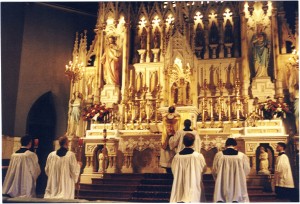Last year, attending the diaconate convocation for the Archdiocese of Detroit, I wrote about how my husband and I were privileged to pray before a first-class relic of St. Teresa of Avila.
And What, Exactly, Is a Relic?
First, let’s clear up what it’s not. Catholics do not, under any circumstances, “worship” relics.
St. Jerome wrote, “We do not worship, we do not adore, for fear that we should bow down to the creature rather than to the creator, but we venerate the relics of the martyrs in order the better to adore him whose martyrs they are.”
There are three different types of relics:
- First-Class Relics are items directly associated with the events of Christ’s life (the manger, the cross, etc.), or the physical remains of a saint (a bone, a hair, skull, a limb, etc.).
- A Second-Class Relic is an item which was worn by a saint (such as a shirt or a glove), or which the saint owned or frequently used (such as a crucifix or book).
- A Third-Class Relic is an object that is touched to a first- or second-class relic. Most third-class relics are small pieces of cloth.
Relics from the life of Christ include, most famously, the Shroud of Turin. Pieces of the True Cross among the most prized First-Class Relics; many churches claimed to possess a piece of it, so many that John Calvin once remarked that there were enough pieces of the True Cross to build a ship. Calvin’s assertion was disproven in an 1870 study which found that all the known pieces of the cross, if put together,would weigh less than 1.7 kg.
Is Praying With a Relic Merely a Catholic Superstition?
Catholics believe that only God can heal, but that God may in some cases permit healing through physical means, such as a relic of a holy person. The Holy Spirit’s indwelling can affect the physical body, and God can work miracles through the bodies of deceased saints. As far back as the Old Testament, the relics of the deceased have been shown to possess a power which certainly comes from God.
One of the earliest verses which shows the efficacy of relics is in the Old Testament book of Second Kings (2 Kings 13:20-21). The prophet Elisha had died and his body had been buried. In the spring of the year, an invading band of Moabites was burying a man from their tribe when they came upon the grave of Elisha. The Moabites tossed the deceased man into the grave, atop the bones of Elisha; and as soon as he touched the bones, the man was revived and stood on his feet.
And in the New Testament, Acts 19:11-12 recounts the story of Paul’s handkerchiefs, which were imbued by God with healing power.
Can Relics Be Bought or Sold?
A quick check of E-bay turns up several relics, either real or purported, which are offered for sale—sometimes for hundreds of dollars. The Catholic Church, though, strictly forbids the sale of relics. The Code of Canon Law states:
§1190 §1 – “It is absolutely forbidden to sell sacred relics.”
§1190 §2 – “Relics of great significance and other relics honored with great reverence by the people cannot be alienated validly in any manner or transferred permanently without the permission of the Apostolic See.”











